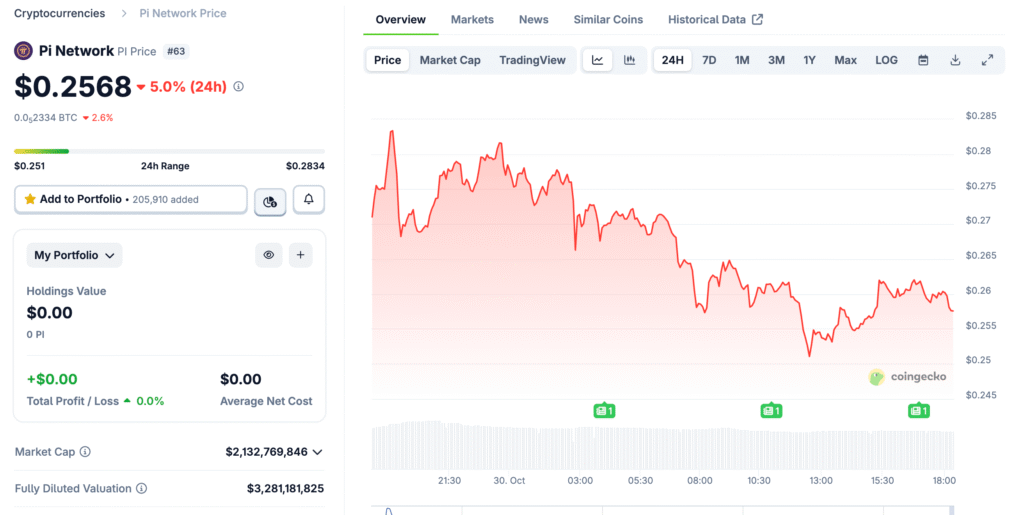Pi Network’s Massive Growth Brings Mixed Reactions
Pi Network has evolved from a mobile mining experiment into a global cryptocurrency project boasting over 65 million active users. The recent rollout of its open mainnet has reignited both excitement and skepticism among the crypto community. Supporters view Pi’s growth as proof that accessibility-first crypto models can succeed without costly mining hardware. However, critics argue that user count alone doesn’t equal trust, especially when transparency about token listings and governance remains limited.

Mainnet Launch Expands Utility But Raises Key Questions
The introduction of Pi Network’s open mainnet was a milestone moment for the project’s long-term roadmap. Users can now send and receive Pi coins, interact with decentralized applications, and explore an ecosystem that aims to link blockchain with everyday commerce. Yet, despite this progress, the absence of listings on major exchanges continues to cast doubt on the token’s real-world liquidity. Until more regulated trading pairs emerge, Pi’s value proposition will largely depend on internal ecosystem usage rather than external market demand.
A Closer Look at Pi Network’s Founders and Vision
Founded by Stanford graduates Dr. Nicolas Kokkalis and Dr. Chengdiao Fan, Pi Network was designed to make cryptocurrency participation simple and inclusive. Their academic background helped build credibility early on, attracting millions of non-technical users through a mobile-first approach. The project’s core idea—allowing mining through smartphones without high energy costs—appealed strongly to emerging markets. Yet, as the platform scales, some experts question whether its simplified consensus model can maintain true decentralization under such massive growth.
Recommended Article: Pi Network Sells Off After App Studio Update as Fundamentals Face Scrutiny
How Pi Network Mining Actually Works
Pi’s mobile mining system allows users to earn tokens by opening the app daily and tapping a button, a process requiring neither specialized hardware nor excess energy. This gamified system encourages user engagement and referrals, turning mining into a social activity. However, blockchain analysts note that this process doesn’t involve actual computational validation like Proof-of-Work or Proof-of-Stake systems. The approach focuses on participation rather than security, which may leave the network vulnerable until additional consensus safeguards are implemented.
Concerns About Centralization and Data Privacy Grow
One of the most persistent criticisms against Pi Network concerns its centralized control and data-collection practices. Users are required to complete KYC verification using personal documents, but details about data handling and storage remain unclear. Privacy advocates worry that the platform could be collecting vast amounts of sensitive information without transparent safeguards. Until Pi’s governance structure becomes more community-driven and its privacy standards independently audited, questions about trust will likely continue.
Community Momentum and Real-World Adoption Efforts
Despite ongoing concerns, Pi Network’s community remains one of the largest and most active in crypto. Developers are introducing new Pi-based applications, such as shopping platforms, games, and social tools that reward engagement. These use cases, while still limited, demonstrate Pi’s ambition to transition from a passive mining app to a functioning digital economy. The introduction of unique .pi domain names and programs like PiFest illustrate the network’s attempt to establish brand identity and user-level utility.
Conclusion: A Promising Project Still Facing Trust Barriers
Pi Network stands at a crossroads between legitimacy and speculation. Its enormous user base and expanding ecosystem suggest potential for real impact, yet doubts persist about decentralization, transparency, and long-term value. Until the token is consistently traded on major exchanges and subject to stronger regulatory oversight, many analysts will remain cautious. For now, Pi represents both the promise and pitfalls of accessible crypto innovation—a reminder that adoption without clarity can fuel as much uncertainty as progress.























